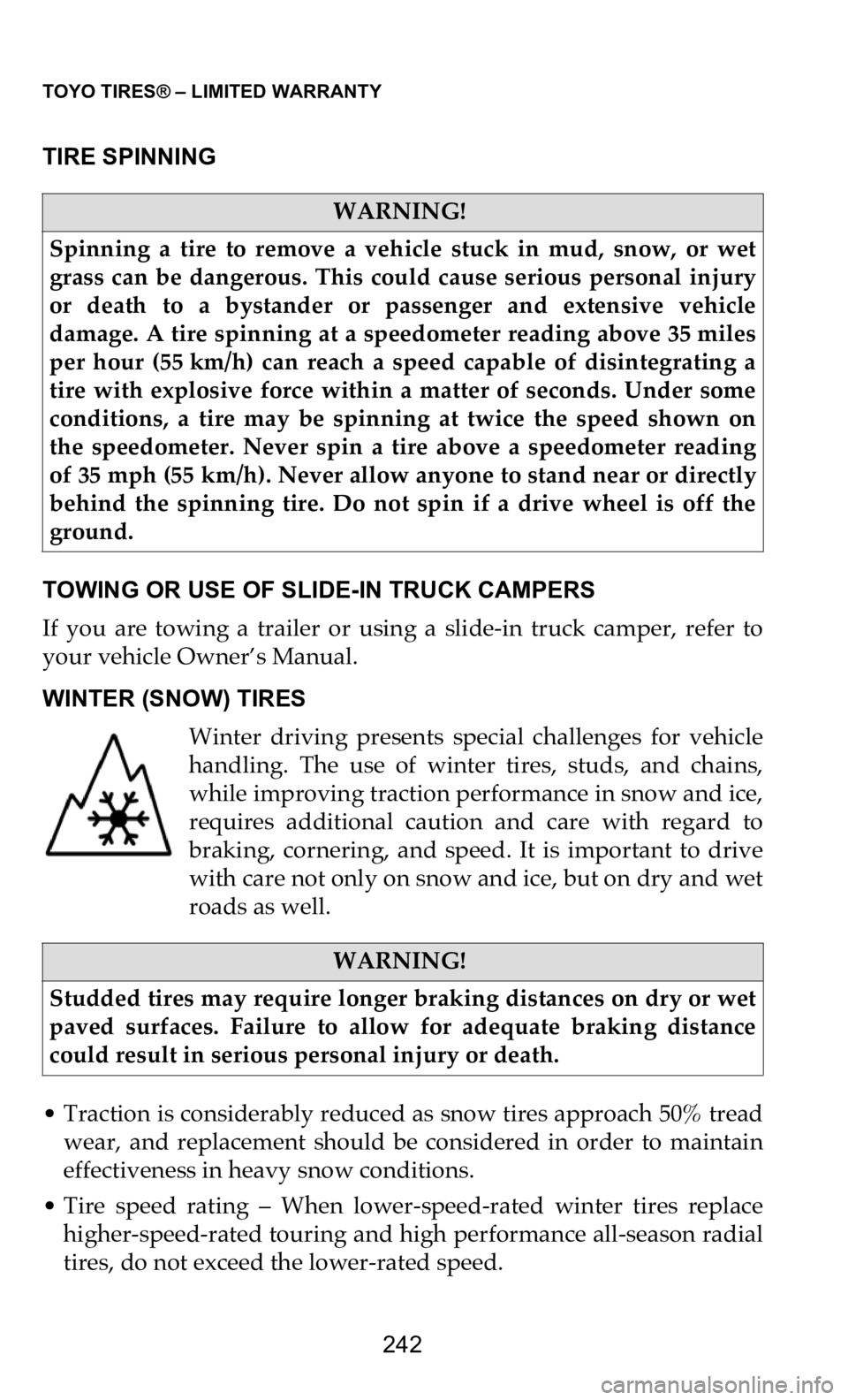snow chains DODGE DURANGO 2021 Vehicle Warranty
[x] Cancel search | Manufacturer: DODGE, Model Year: 2021, Model line: DURANGO, Model: DODGE DURANGO 2021Pages: 262, PDF Size: 10.42 MB
Page 64 of 262

BRIDGESTONE® - FIRESTONE®
63
HIGH PERFORMANCE, LOW ASPECT RATIO TIRES
Many new vehicles come equipped from the factory with high
pe
rformance and/or low aspect ratio tires. Generally, these tires
provide increased vehicle handling capability, but may also have
numerous engineering performance trade-offs associated with their
designs.
• Low aspect ratio tires, with reduced sidewall height, may be more
s
usceptible to damage from potholes, road hazards, and other
objects such as curbs. This is true for the wheels as well. Therefore,
as with all other tires, it is important to drive with care and maintain
proper inflation pressure and load conditions. See “Tire Inflation
Pressure” and “Tire Damage, Inspection and Service Life” in this
manual.
• Some sports cars and other handling performance enhanced vehi -
c
les, including sedans and light trucks/SUVs, may be originally
eq
uipped with high performance tires that are more optimized for
warmer weather use. Colder, winter weather traction may be
reduced for these types of tires. Winter tires may be recommended
by the vehicle manufacturer for colder weather application. See
“Winter Tires,” the next section in this manual.
• High performance tires may also wear more quickly, ride more
f
irmly, and produce more noise during operation.
Consult your vehicle Owner’s Manual and tire information placard, or
a
qualified tire service professional, for more information and
specifics regarding these types of tires.
WINTER TIRES
In Winter driving conditions, vehicle control and safe operation under
b r
aking and cornering is especially dependent upon the rear tires. For
this reason, Winter tires are best applied to all wheel positions. Some
WARNING!
Winter driving presents special challenges for vehicle mobility.
Th
e use of winter tires (including studs and chains)—while
improving traction performance in snow and ice—requires special
care with regard to acceleration, braking, cornering, and speed. It
is important to drive with care, not only on snow and ice, but on
dry and wet roads as well.
Page 89 of 262

CONTINENTAL TIRE
88
•Improper operation or maintenance: This includes, but is not
limited to, effects caused by:
1. Improper tire inflation and/or improper load/speed prac -
t
ices: These practices can cause excessive operational
t
emperatures and stresses that exceed the tire’s capabilities.
2. Improper or insufficient tire rotation
3
. Improper vehicle alignment
4
. D amage due to:
–
Rim irregularities or rim damage
–
Snow chains
–
Vehicle mechanical problems, including brake problems,
a
nd vehicle wheel alignment
– Extreme temperature exposure
–
Negligent and abusive driving such as tire spinning, or
r
acing
– Improper tire storage
–
Automotive accident
–
Chemical corrosion or fire
–
Use contrary to the vehicle manufacturer’s tire recommen -
d
ations
– Misuse or misapplication
•
Improper Mounting or Demounting
•Alteration: such as, but not limited to, adding a white inlay on
black wall, tread regrooving, tire truing or siping, or adding
sealant materials to the tire.
•
Weather checking/cracking: Not covered after 48 months from
th
e date of purchase.
• Failure to observe safety and maintenance precautions set forth
i
n the Safety Warning Section.
ATTENTION AUTHORIZED DEALERS: CONTINENTAL TIRE
TH
E AMERICAS, LLC (CTA) RESERVES THE RIGHT TO THE
FINAL INSPECTION DECISION FOR ALL RETURNED TIRES
ON CONDITIONS UNDER SECTION 3.
THIS WARRANTY IS MADE IN LIEU OF ALL OTHER
WA
RRANTIES, EXPRESS OR IMPLIED, AND CTA EXPRESSLY
DISCLAIMS ALL IMPLIED WARRANTIES, INCLUDING, BUT
Page 116 of 262

GENERAL TIRE
115
• Repairs: If a tire is returned under complaint and the reason for the
tire’s disablement is in any way associated with a repair, or with the
situation that led to the repair, the manufacturer’s warranty is inval -
idated.
• Mileage: T
read wear out up to a predetermined mileage is not
covered under this policy.
• Improper operation or maintenance: T
his includes, but is not
limited to, effects caused by:
• Improper tire inflation and/or improper load/speed practices: T
hese practices can cause excessive operational temperatures
and stresses that exceed the tire’s capabilities.
• Improper or insufficient tire rotation
•
Improper vehicle alignment
•
Damage due to:
–
Rim irregularities or rim damage
–
Snow chains
–
Vehicle mechanical problems, including brake problems, and
v
ehicle wheel alignment
– Extreme temperature exposure
–
Negligent and abusive driving such as tire spinning, or racing
–
Improper tire storage
–
Automotive accident
–
Chemical corrosion or fire
–
Use contrary to the vehicle manufacturer’s tire recommenda -
t
ions
– Misuse or misapplication
•
Improper Mounting or Demounting
•
Alteration: s
uch as, but not limited to, adding a white inlay on black
wall, tread regrooving, tire truing or siping, or adding sealant mate -
rials to the tire.
• Weather checking/cracking: N
ot covered after 48 months from the
da
te of purchase.
• Failure to observe safety and maintenance precautions set forth in
t
he Safety Warning Section.
Page 187 of 262

NEXEN TIRE
186
WHAT IS NOT COVERED UNDER THE ROAD HAZARD
REPLACEMENT PROGRAM
• A tire that is damaged due to vandalism.
•
A tire that is damaged due to an accident.
•
A tire that is repairable under Rubber Manufacturers Association
(
RMA) standards.
• A tire that has failed due to commercial use.
•
A tire that is damaged or failed due to racing or off road use.
•
A tire that is damaged due to use of snow chains or studs.
•
A tire that is damaged or failed due to irregular wear caused by
m
echanical issues.
• Original equipment tires on new vehicle.
•
Tires transferred from the vehicle that they were originally installed.
C
ONSUMER’S OBLIGATION WHEN FILING CLAIM
To maintain Mileage Tread Wear Warranty and Road Hazard
Re
placement Program, the consumer is responsible for the following:
• Any claims must be presented to an authorized NEXEN TIRE
d
ealer.
• Submit or present a copy of the original purchase receipt with docu -
m
ented automobile mileage at time of tire installation and of tire
di
smounting.
• Submit a tire rotation record showing that all tires have been rotated
a
t least every 5,000-6,000 miles (8,000-10,000 km). Tire rotation
re
cord is not necessary for Mileage claims when tire is within 2/32”
difference of remaining tread depth as measured from shoulder to
shoulder on the claim tire, and compared to the remaining tread
depth of the opposite front/rear or left/right tire.
• Complete and sign the NEXEN TIRE Claim Adjustment form
p
rovided by the dealer, keep a copy for your records and leave the
tire with the dealer for warranty processing.
ROADSIDE ASSISTANCE
Patterns sold after May 1st 2014 by NEXEN TIRE in the United States
an
d Canada are eligible for a free 24/7/365 Roadside Assistance for a
period of 36 months from the purchase date. Upon purchasing Nexen
ti
res, the consumer will receive an activation card from the tire shop.
An online registration needs to be completed in order to have access
Page 243 of 262

TOYO TIRES® – LIMITED WARRANTY
242
TIRE SPINNING
TOWING OR USE OF SLIDE-IN TRUCK CAMPERS
If you are towing a trailer or using a slide-in truck camper, refer to
y o
ur vehicle Owner’s Manual.
WINTER (SNOW) TIRES Winter driving presents special challenges for vehicle
handling. The use of winter tires, studs, and chains,
wh
ile improving traction performance in snow and ice,
requires additional caution and care with regard to
braking, cornering, and speed. It is important to drive
with care not only on snow and ice, but on dry and wet
roads as well.
• T raction is considerably reduced as snow tires approach 50% tread
w
ear, and replacement should be considered in order to maintain
effectiveness in heavy snow conditions.
• Tire speed rating – When lower-speed-rated winter tires replace
h
igher-speed-rated touring and high performance all-season radial
tires, do not exceed the lower-rated speed.
WARNING!
Spinning a tire to remove a vehicle stuck in mud, snow, or wet
gr
ass can be dangerous. This could cause serious personal injury
or death to a bystander or passenger and extensive vehicle
damage. A tire spinning at a speedometer reading above 35 miles
pe
r hour (55 km/h) can reach a speed capable of disintegrating a
ti
re with explosive force within a matter of seconds. Under some
conditions, a tire may be spinning at twice the speed shown on
the speedometer. Never spin a tire above a speedometer reading
of 35 mph (55 km/h). Never allow anyone to stand near or directly
be
hind the spinning tire. Do not spin if a drive wheel is off the
ground.
WARNING!
Studded tires may require longer braking distances on dry or wet
pa
ved surfaces. Failure to allow for adequate braking distance
could result in serious personal injury or death.
Page 244 of 262

TOYO TIRES® – LIMITED WARRANTY
243
• Follow recommendations in the vehicle Owner’s Manual for winter
tires, studs, and chains.
• Consult your tire dealer, the Rubber Manufacturers Association
w
ebsite
www.rma.org
, or your state’s Department of Transportation
(DOT) for information regarding regulatory and seasonal restric -
tions for stud usage.
• Also see the “Tire Mixing” section in this manual for more details.
•
Toyo Tires recommends that snow tires be installed in matched sets
o
f four.
ADVERSE WEATHER DRIVING
Take special care when driving in adverse weather conditions.
• Rain and snow – Driving in rain or snow considerably reduces the
t
raction between your tires and the road surface. You must always
reduce your speed to allow additional stopping distance between
you and the vehicles ahead of you.
• Hydroplaning and wet weather driving – Hydroplaning occurs on
w
et roads and refers to the loss of tire contact with the road due to
the build-up of water between the tire contact patch and the road
surface. Three main factors affect hydroplaning and, consequently,
your tire traction on wet roads:
1. Vehicle Speed – As speed increases, wet traction is considerably
r
educed.
2. Water Depth – The deeper the water, the sooner your tires will lose
t
raction. Even thin water layers can create sufficient lubrication to
cause traction loss at low speeds, depending on road conditions.
3. Tire Tread Depth – As your tires wear down, their decreased ability
t
o resist hydroplaning can result in a complete loss of traction and
vehicle control. You should always reduce your speed with consid -
eration for the traffic around you.
• Driving on ice and snow – Your all-season tires were designed to
p
rovide higher levels of snow traction compared to non-all- season
tires. You have all-season tires if you find the letters “M&S” are
molded into the sidewall near the bead. These letters mean “Mud and
Snow.” Tires designed for use in severe snow conditions generally
have tread patterns, structure, and materials for giving superior
performance. These tires are marked with the “M&S” designation
Page 245 of 262

TOYO TIRES® – LIMITED WARRANTY
244
plus a mountain/snowflake symbol . Even the best all-season tires
will not provide acceptable levels of traction if you drive too fast in
snow or ice conditions and if you do not allow more stopping
distance on icy roads compared to dry road surfaces. Your ability to
safely maneuver your vehicle in snow or ice conditions is consider -
ably reduced if your tires are too worn to provide adequate road grip.
SAFE USE OF TEMPORARY SPARE TIRES
• T he temporary spare tire is designed for temporary use only. It must
n
ot be used continuously as a standard tire. The temporary spare
tire should be returned to the trunk as soon as it is convenient to
have your standard tire repaired or replaced.
• The temporary spare tire should not be used for speeds exceeding
5
0 mph.
• Never use chains on temporary spare tires, because it could cause
d
amage to your vehicle.
• When you replace the temporary tire, replace it only with the same
t
ype of tire.
• A full-size spare tire in your vehicle is intended for use as a spare
w
hen needed. Please see the “Tire Rotation” section for the proper
procedures for including the same size construction and
speed-rated tire (for LT tires of the same size, type, and load rating)
in the rotation pattern. Do not rotate a temporary spare tire.
WARNING!
The spare tire your car is equipped with may be of a different size
an
d construction from the other tires on your vehicle. When using
any temporary type spare tire, be sure to follow the vehicle
manufacturer’s instructions. Failure to observe recommended
precautions could lead to erratic vehicle behavior and/or tire
damage, possibly resulting in an accident and serious personal
injury or death.
Page 260 of 262

YOKOHAMA TIRES — LIMITED WARRANTY
259
6. Do not use snow chains on your YOKOHAMA high pressure
spare. This could cause damage to your vehicle.
7. When the tread wear indicator appears on the tire, replace it only
w
ith the same type spare tire.
8. Check the tire’s cold inflation pressure monthly and maintain at 60
p
si (4.2 kg/cm2) even when not in use. Do not inflate over 60 psi.
9. The YOKOHAMA high pressure spare tire should not be used with
a
ny other rim nor should standard tires, wheel covers, or trim rings
be used on the YOKOHAMA high pressure spare tire rim on which
the YOKOHAMA high pressure spare tire was originally installed.
IMPORTANT SAFETY INFORMATION
All tires require owner maintenance regardless of how well a tire is
co
nstructed. Operational damages such as punctures, impact
damage, cuts, incorrect inflation, etc., may cause tire failure and
subsequent personal injury and/or property damage. Simple
operational and maintenance practices, as listed below, will reduce
the chances of tire problems.
Tire Inspection
Visually inspect your tires frequently for any tire damage such as
sc
rapes, bulges, cuts, nails, irregular wear, etc. resulting from
operation. This must be done immediately after any known or
suspected contact with an object in the road, a pothole, road
irregularity or after severe braking. Refer these conditions to a
reputable tire service center for repair or replacement. Never drive on
a tire if such conditions appear.
Tire Loading
Never exceed the maximum vehicle load limit listed on the vehicle
pl
acard, tire information label or in the Owners Manual. Be aware of
the load carrying limits molded into the tire’s sidewall and do not
exceed those limits. Maximum load can only be carried at the
maximum cold inflation pressure indicated on the tire’s sidewall.
Speed Limits
Regardless of the speed capability of your tires, never exceed lawful
sp
eeds or speeds dictated by driving conditions.